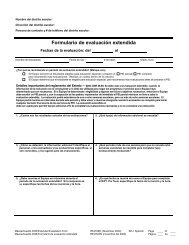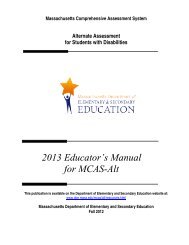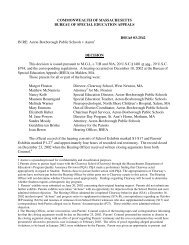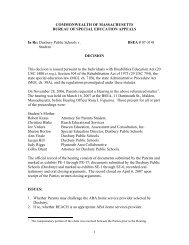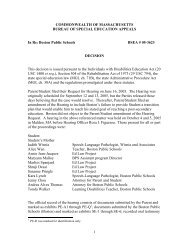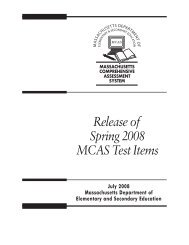Guidance for Massachusetts Public Schools Creating a Safe and ...
Guidance for Massachusetts Public Schools Creating a Safe and ...
Guidance for Massachusetts Public Schools Creating a Safe and ...
You also want an ePaper? Increase the reach of your titles
YUMPU automatically turns print PDFs into web optimized ePapers that Google loves.
the sex of female at birth but has a clear <strong>and</strong> persistent identity as male. A transgender girl is a<br />
youth who was assigned the sex of male at birth but has a clear <strong>and</strong> persistent identity as<br />
female. Gender noncon<strong>for</strong>ming youth range in the ways in which they identify as male, female,<br />
some combination of both, or neither.<br />
The responsibility <strong>for</strong> determining a student’s gender identity rests with the student or, in the<br />
case of young students not yet able to advocate <strong>for</strong> themselves, with the parent.5 One’s gender<br />
identity is an innate, largely inflexible characteristic of each individual’s personality that is<br />
generally established by age four, although the age at which individuals come to underst<strong>and</strong><br />
<strong>and</strong> express their gender identity may vary based on each person’s social <strong>and</strong> familial social<br />
development.6 As a result, the person best situated to determine a student’s gender identity is<br />
that student himself or herself.<br />
In one <strong>Massachusetts</strong> town, the parents of a pre-school-age biologically female child<br />
noted throughout the child’s early years that their child identified as a boy. For as long<br />
as the parents could remember, the child preferred to play with boys rather than girls,<br />
wanted a short haircut, rejected wearing any clothing that the child identified as<br />
“something a girl would wear,” <strong>and</strong> ignored anyone who called him by his stereotypically<br />
feminine name. When it was time <strong>for</strong> the child to enter kindergarten, the child said to<br />
his parents, “You have to tell them when I go to kindergarten that I’m a boy.”<br />
Consistent with the statutory st<strong>and</strong>ard, a school should accept a student’s assertion of his or<br />
her gender identity when there is “consistent <strong>and</strong> uni<strong>for</strong>m assertion of the gender-related<br />
identity, or any other evidence that the gender-related identity is sincerely held as part of a<br />
person’s core identity.” If a student’s gender-related identity, appearance, or behavior meets<br />
this st<strong>and</strong>ard, the only circumstance in which a school may question a student’s asserted<br />
gender identity is where school personnel have a credible basis <strong>for</strong> believing that the student’s<br />
gender-related identity is being asserted <strong>for</strong> some improper purpose.<br />
In most situations, determining a student’s gender identity is simple. A student who says she is<br />
a girl <strong>and</strong> wishes to be regarded that way throughout the school day <strong>and</strong> throughout every, or<br />
almost every, other area of her life, should be respected <strong>and</strong> treated like a girl. So too with a<br />
student who says he is a boy <strong>and</strong> wishes to be regarded that way throughout the school day<br />
<strong>and</strong> throughout every, or almost every, other area of his life. Such a student should be<br />
respected <strong>and</strong> treated like a boy.<br />
The statute does not require consistent <strong>and</strong> uni<strong>for</strong>m assertion of gender identity as long as<br />
there is “other evidence that the gender-related identity is sincerely held as part of [the]<br />
person’s core identity.” Many transgender people experience discrimination, <strong>and</strong> some<br />
5 When used in this document, the term “parent” refers to parent as well as legal guardian.<br />
6 See Gerald P. Mallon, “Practice with Transgendered Children,” in Social Services with Transgendered<br />
Youth 49, 55-58 (Gerald P. Mallon ed., 1999). See also Stephanie Brill & Rachel Pepper, “Developmental<br />
Stages <strong>and</strong> the Transgender Child,” in The Transgender Child, 61-64.





